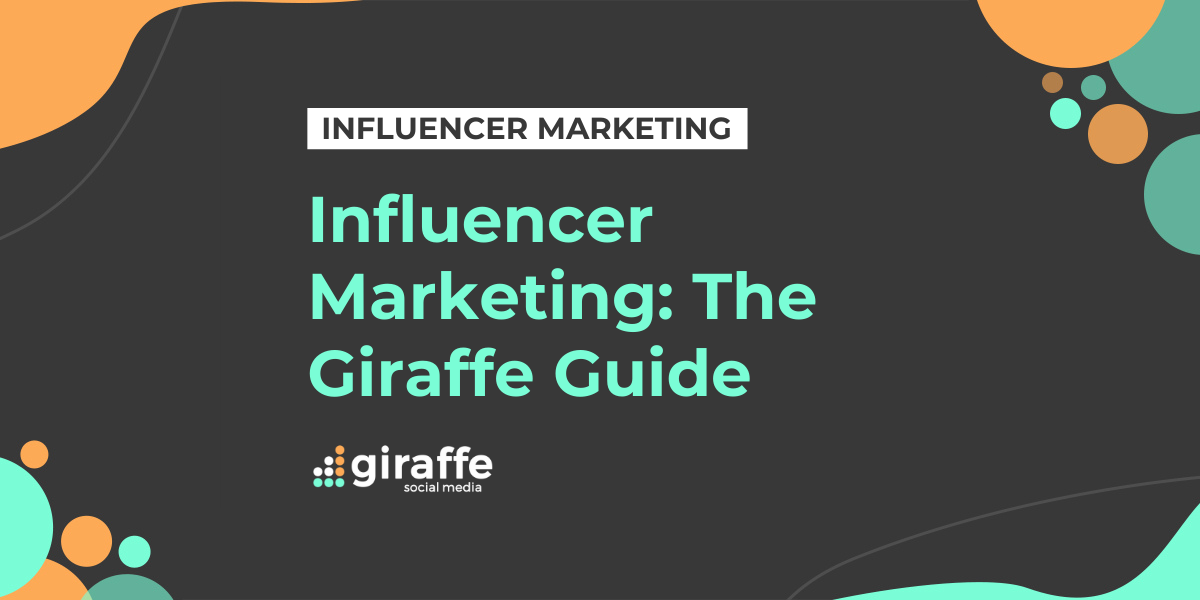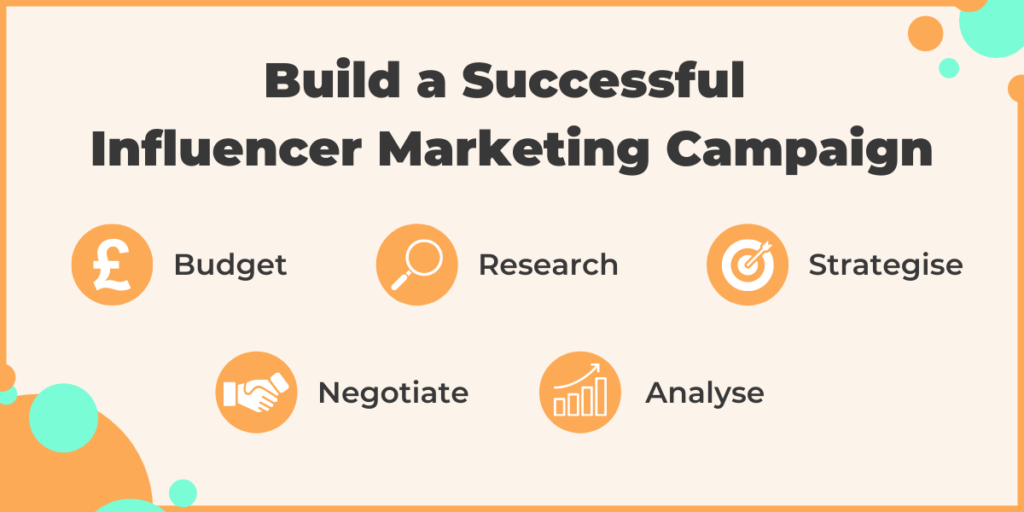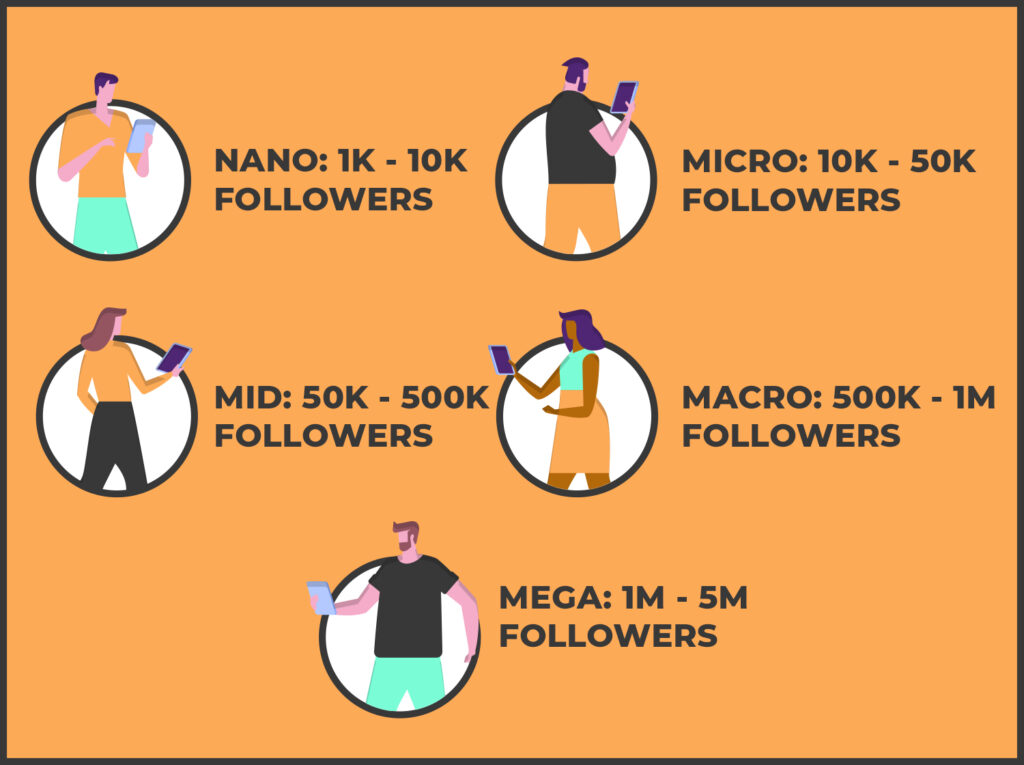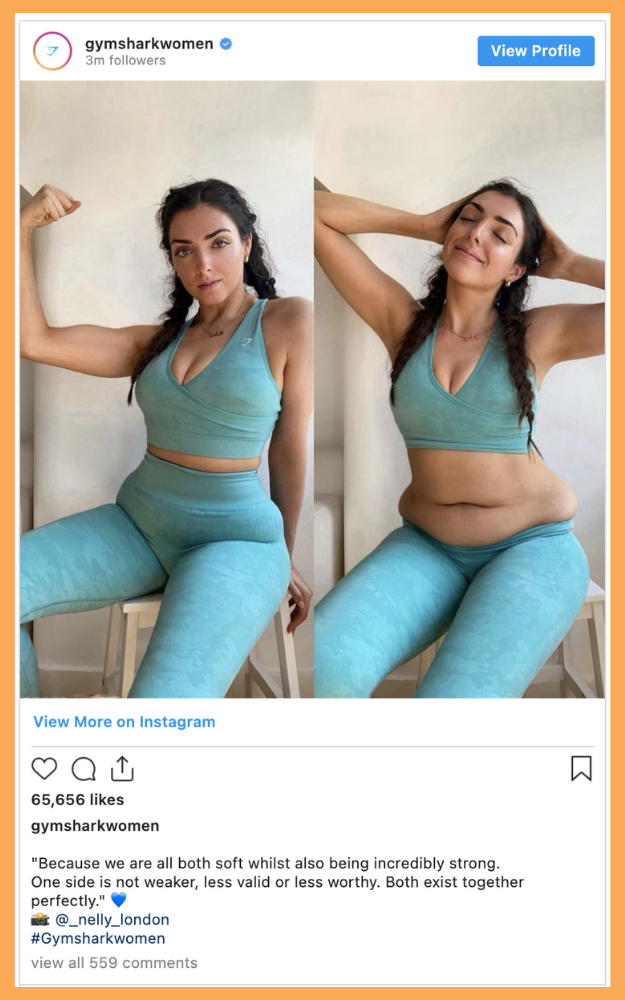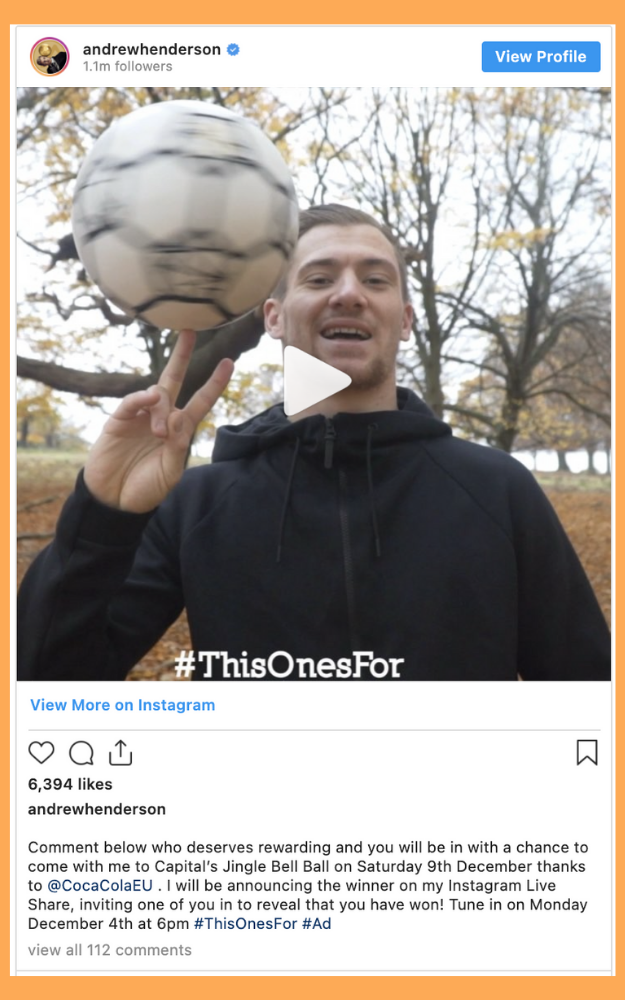Influencer marketing is now one of the most popular ways to market your business and products, but many do not fully understand what it is and what they need to do to create successful influencer marketing campaigns – so this influencer marketing guide has been developed to help you.
There’s so much to learn about influencer marketing that it can be a daunting and confusing branch of digital marketing.
Giraffe is here to help you untangle the mess and show you how you can start using influencer marketing to create compelling, effective influencer campaigns with the help of the Giraffe Influencer Marketing guide.
Table of Contents
1. What is Influencer Marketing?
2. The History of Influencer Marketing
3. What is an Influencer?
4. Creating an Influencer Strategy
5. Choosing the Right Campaign Type
6. Different Types of Influencers
7. What Are the Benefits of Influencer Marketing?
8. Influencer Marketing Case Studies
9. The Future of Influencer Marketing
10. How Giraffe Social Media Can Help You
What is Influencer Marketing?
Influencer marketing includes aspects of both old and new ways to market a product or brand. It takes the traditional route of celebrity endorsement and updates it to the new modern era of content-driven marketing campaigns. These campaigns usually involve collaboration between brands and potential brand ambassadors from within your industry/niche. Therefore, social media strategies in influencer marketing are aimed at individuals who influence your own target audience.
Giraffe’s own Senior Social Media Manager Dominic states that “Influencer marketing is any process that promotes or advertises a product, service, website, or brand by using the reach and mass appeal of influential individuals. This includes sponsored content featured on the influencer’s social media profiles and their blogs, recommendations and reviews by the influencer, and promotions featuring the influencer talking favourably about the product or service.”
The History of Influencer Marketing
Before delving into this influencer marketing guide, it’s important we understand the origins of the marketing technique. Influencer marketing has been around a lot longer than you’d think, just not in the way we know it now. Before social media, influencer marketing was more associated with influential characters that invoked emotion. For example, a cartoon character on cereal boxes that featured in television advertisements, or the use of Santa in Coca Cola Christmas adverts.
As common for marketing trends, this popular trend eventually died down, and marketers needed a new way to sell brands – enter… celebrity endorsement. Big brands would pay celebrities to talk about their products in testimonials or feature them in television adverts. When social media became evolved, celebrities became brand advocates and ambassadors online as well, posting pictures with products to platforms such as Instagram and Snapchat.
In modern-day social media, the role of the influencer has vastly expanded and there are now thousands of influencers for every industry, big or small. You can read more about influencer marketing and its evolution from B2B and celebrity endorsements, to the more niche content we see today, in our blog: Influencer Marketing – The 4 M’s.
What is an Influencer?
Influencers are social media content creators who have built credibility and thought leadership for themselves within a certain industry or niche. According to Mediakix, an influencer must be “a content creator with a social media following”. They “develop a following by sharing high-quality content that inspires, entertains, informs, and connects them with their followers.”
Influencers aren’t just people you can pay to get what you want. Good, trustworthy influencers have built their own brand image and industry credibility, collated a large following, and are responsible for gaining the trust of their audience. They have a lot of respect for their followers, making them feel cared about and listened to. This cultivates a real sense of community with the influencer’s followers.
As Alexa state, “Influencer marketing is about gaining exposure, but it isn’t always about working with people who have the largest audience”. It’s about finding a person who shares the same values as you, has a similar audience and can promote your product or service in a way that is appropriate and mutually beneficial for the audiences and brands involved.
Creating an Influencer Strategy
Building a successful influencer marketing campaign starts with developing your budget, strategy, and content plan. This influencer marketing guide well help you develop all three.
There are five key steps to building a successful influencer marketing campaign:
- Setting your budget and managing expectations
- Researching relevant influencers in your industry and choosing a social media platform for your campaign
- Determining your goals, strategy, and timeline for the campaign and/or ongoing influencer relationship
- Reaching out to influencers to negotiate and create a deal
- Monitoring and analysing results to make campaign improvements or use the data to help inform future campaign decisions.
When determining your goals and what you’re going to measure, there is a long list of methods and strategies to choose from. Alexa identifies all of these as potential goals as:
- Brand awareness: getting more people to know, recognise, and like your brand
- Building brand identity: getting people to see your brand personality and values
- Audience growth: getting more people to like/follow/subscribe.
- Engagement: getting more shares, comments, and likes for your content
- Lead generation: getting more people to sign up for your lead magnets and offers
- Sales: getting more people to purchase your products/services
- Customer loyalty: getting people to stay interested and connected with your brand
- Link building: getting more links directed back to your website.
You can personalise these goals and tailor them to your business aims and strategy. You can have multiple goals, but make sure your tracking and reporting are top-notch so you don’t lose sight of your goals.
Choosing the Right Campaign Type
After you’ve chosen your goals, then it’s time for the next step of this influencer marketing guide – the influencer marketing campaign. You can come up with a strategy and build a campaign around your product or service, but your potential influencers will need to get on board. For example, you could build a competition where an influencer will get free clothes if they share a competition, offering their audience free clothes if they like, share and comment on the post and follow your account too.
However, some influencers may not feel a competition fits in with their feed or it’s not what they want to give out to their audience. Thus, you’d have to change your campaign if you wanted to get the influencer on board. It’s important to be flexible and understand your dealing with real people; but also, stick to your guns if a particular campaign type is important to you, there are other influencers out there!
According to Alexa, influencer marketing campaigns involve three types of relationship triggers, “inspire, hire, or a mix of both.” They continue, ‘You can inspire an influencer to share your content or messaging on their own. You can pay them to promote your brand. Or you can create a situation that uses a little bit of both.’ It all comes down to what you want, what they want, and what you’re willing to give away.
Alexa have provided a few types of influencer marketing content types and strategies that you may want to use in your campaign:
- Gifting free products or services in exchanges for reviews or mentions.
- Guest posting on industry influencer blogs.
- Creating sponsored content for an influencer’s blog or social channel.
- Co-creating content with an influencer for your use, their use, and/or third-party use.
- Social media mentions from the influencer sharing your content or posting directly relating to your brand/product.
- Contests and giveaways run with or by the influencer. Read our influencer marketing guide for running giveaways with influencers here.
- Allowing the influencer to take over your social media page(s) for a set amount of time.
- Affiliate marketing, giving influencers a percentage of earnings from discount codes or URLs they share (unique to them/the campaign).
- Discount codes provided to the influencer that they then use and/or promote to their audience
- Creating brand ambassadors by forming relationships with loyal, influential fans. Often, in return, the influencer will receive free/discounted products, content features, and exclusive offers.
You may need to compromise when it comes to getting the influencer of your dreams, as your values and content styles may not match 100%. But that’s okay! You’ve both got reputations to uphold, so, if they don’t like your idea, you can either change it or go your separate ways.
Remember to stay flexible and do your research on your market and the types of influencers available. This means you can come up with a customised strategy that influencers will want to say “yes” to.
Different Types of Influencers
After you’ve built your strategy with the help of this influencer marketing guide, you can begin finding the right influencer(s) for your brand and campaign.
There are different types of social media influencers depending on the number of followers an individual has.
Nano
Nano-influencers are social media users with 1k to 10k followers. Nano is a fairly new category of influencers, deriving from the uptake in brands working with influencers with smaller followings.
Micro
Micro-influencers have anywhere between 10k to 50k followers on their social media platform.
Mid
Mid influencers have climbed the social ranks to earn between 50k to 500k followers.
Macro
Macro-influencers have between 500k to 1m followers, with a lot of influence over their audience.
Mega/Celebrity
Mega-influencers have the highest number of followers and are often on par with celebrities. They can have a following anywhere between 1m and 5m.
Fully-fledged celebrity influencers will often have over 5m followers. Generally, they’ll have more fame than influence over their audience.
Choose an influencer based on their community and message/values rather than the audience size that they have. Larger audiences generally even out with lower engagement rates, due to the sheer volume of followers. This is great for reach, but if you’re looking for ultra-engaged audiences, nano and micro-influencers might be your best bet.
Influencing on Different Social Platforms
Influencer marketing can be on any social media platform, including YouTube, Snapchat, Pinterest, Instagram, Facebook, Twitter and LinkedIn. As long as there’s an influential individual in your industry on a social media platform, you can conduct influencer marketing campaigns and cultivate relationships with them.
Each platform offers a different type of following, so each influencer offers a different kind of service. Each social media site has different post types too, so the platform you pick should reflect what you want to achieve. For example, going live, posting videos and sharing dreamy images all work well on Instagram, making it one of the most popular platforms for the influencing service.
Data from Mediakix’s 2019 Influencer Marketing Survey shows that Instagram comes out on top as people’s favoured, most valued social media channel for influencer marketing.
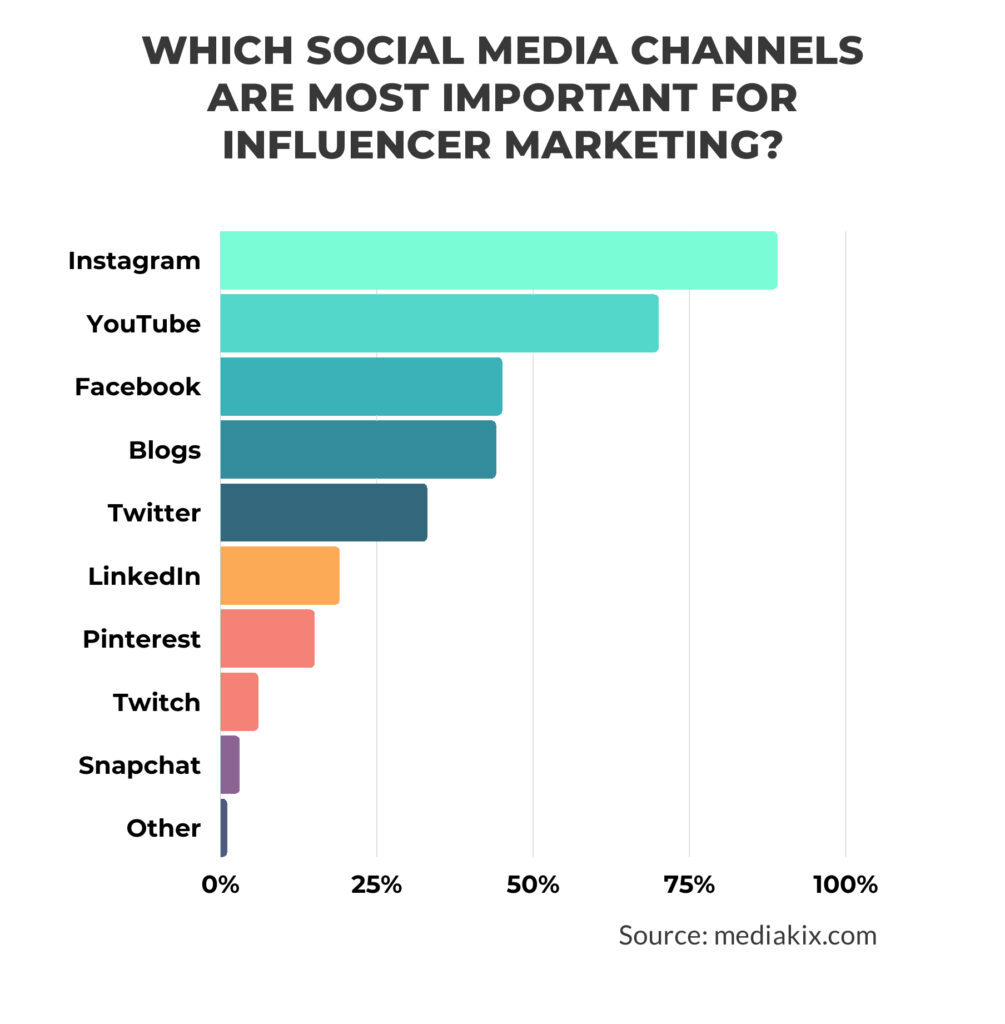
A more recent platform for influencer marketing is TikTok. Launched in 2017 and reaching 2 billion downloads in February 2019, TikTok currently has a user base of over 689 million active monthly users. To put this in perspective, it took just 3 years to achieve the same amount of monthly active users that took Facebook 4 years and Instagram 6 years to achieve.
As explained by Influencer Marketing Hub, it’s important to appeal to the younger demographic on TikTok with posts that are not overtly sales focused. Young audiences’ aversion to traditional advertisements and obvious sales pitches require brands to be even smarter and more strategic with influencer marketing. Only advertise on TikTok if it fits your target demographic, ensuring you work with influencers that fit your brand and target audience. Sending free products, offering discount codes to influencers and their audiences, and creating unique content featuring your brand are all great ways to advertise on TikTok without coming across as ‘salesy’.
How to Find Influencers
Finding influencers is perhaps one of the lengthiest parts of influencer marketing. It comes down to a lot of research, dedication, and trial & error.
Dominic also provides us with a great way to search for influencers:
“Finding influencers in your niche market is important; their followers are more likely to be interested in your account if it is similar to what the influencer posts and values. This will increase the chances of your account gaining new followers and engagement through an influencer tagging your account on a post they share. One of the best ways in which you can find these influencers is to search for specific hashtags that relate to your brand/products. This works well for Twitter, Instagram and LinkedIn. For Facebook, it may be a lengthier task of going through related profiles and searching for key terms in the search bar. For example, if you’re a company selling mints, we can simply search for ‘#mints’. You will have to look to find a hashtag with a decent size following and see which accounts have the top posts.”
Modern social media marketing software services also offer influencer research tools to help you start your influencer journey.
You’ll have to run extensive research into potential influencer accounts that are relevant to your niche market, considering the following:
- Their number of followers.
- The authenticity and legitimacy of their followers.
- Are their followers within your target audience?
- Account engagement rate.
- Posting activity, frequency, and consistency.
- Does the account reflect your brand’s values and ethics?
You must ensure that your chosen influencer has built a genuine community with real people. There are too many ‘fake followers’ lurking in follower lists, getting harder to detect. Luckily, there are fake follower and bot checker tools available to help you verify the legitimacy of an influencer’s following.
Influencer Marketing, like social media marketing and content marketing, is a steady process that grows over time. It’s not an overnight success, it’s a slow race that will help you win. Focus on building relationships with key industry influencers and it will eventually lead to influencers becoming secure, ongoing brand advocates and loyalists.
How Much Should You Expect to Pay?
There’s no set price for influencer marketing. It’s down to how much you can and want to pay and the compensation the influencer requires for their services. Sometimes your business may not even be offering money, rather free samples/products or discount codes.
For example, if you’re a restaurant you may want to encourage influencers in with a free five-course meal or if you’re a hairdressing salon, you’ll be offering free haircuts and hairstyles to those who’ll promote you online. You may even be offering a free trial of service or software instead of cash. Many influencers will accept products, gifts, and services as a payment method, it just all comes down to what you’re willing to give away and what they ask for.
Some influencers could charge £500 for one Instagram Story, others may refuse to do competitions or giveaways, and others may accept a new t-shirt as their reward. It all comes down to your industry and the type of influencer you choose. This is where building relationships and gaining trust is key.
What Are the Benefits of Influencer Marketing?
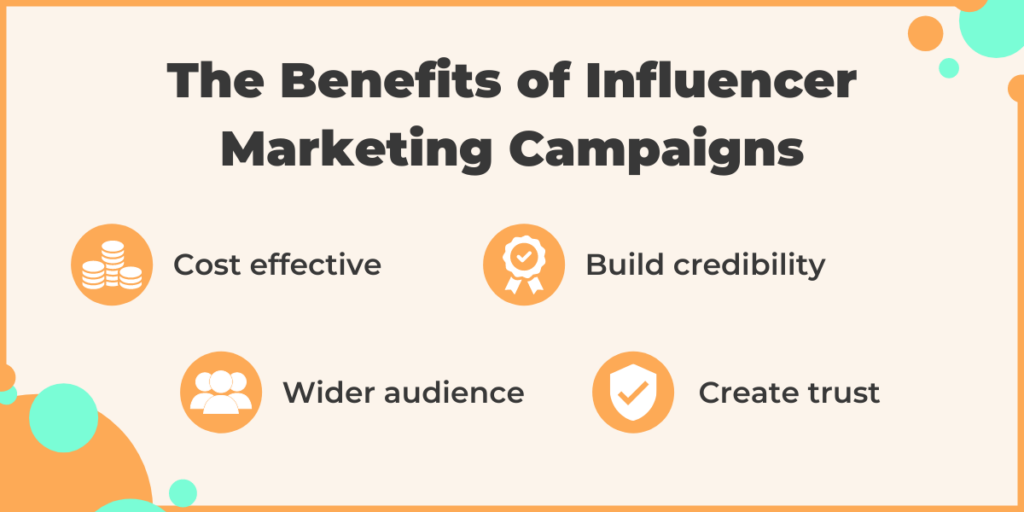
Influencer marketing tends to cheaper and more efficient than other methods in social media marketing, as marketers won’t have to put large sums of money behind running ads to gain reach or engagement.
Influencer marketing now exists in a time when people are questioning the aspects of social media and advertising. Each day, more consumers are questioning the credibility of marketing messages and have become cynical towards the assumptions and huge claims advertisements sometimes make. As Marketing-Schools.org explains, people are more likely to buy a product or listen to an ad, if it’s been recommended by someone they trust.
Therefore, people are more likely to trust an influencer, whose daily life, stories, and secrets are shared on social media, than a new brand who’ve surfaced on their Facebook feed claiming to change their life.
If influencers trust a business enough to promote their products and services, then a fan is likely to trust that business too. Influencer’s audiences are typically hugely interested in a particular niche or industry and are likely to purchase/convert from your influencer campaign. Influencer marketing campaigns are a fantastic way to widen your audience reach and get your brand in front of new people you otherwise may not have been able to reach.
Influencer Marketing Case Studies
Influencer marketing is everywhere at the moment. It’s rare not to find it on your Instagram feed these days, with lots of influencers teaming up with all sorts of brands to promote their products and services. Here are just a few successful influencer marketing campaigns created by big brands:
Gymshark
A great example of brand ambassadors working super well for a brand is Gymshark. Alongside one-off campaigns, Gymshark create ongoing brand ambassador relationships with influencers within the fitness and healthy lifestyle sphere. “These influencers are sent free or discounted products to try, then share their opinions with their followers, giving a personal touch to reviews/recommendations and reaching thousands of potential new Gymshark customers through influencers’ follower bases.” Gymshark are amazing at connecting with their audience and nurturing their relationship with their follower base.
Brand Ambassador and body positivity influencer Nelly London featured in a post on Gymshark Women’s page that went viral.
Read our Gymshark social media case study for more information on how Gymshark utilises social media and influencer/ambassador marketing.
Forever21Plus
Big brand Forever21 – and its social profile “Forever21Plus” for plus-sized clothing – often work with micro-influencers to promote their clothing lines instead of bigger influencers.
Fashion-focused Instagram micro-influencers Kristal Heredia and Arlette Jeanett worked with Forever21Plus to model their plus-sized clothes for sharing on both their feeds and the Forever21Plus social feed. Due to their smaller following, their engagement rates for the campaigns were between 23-25% – an incredible result for Forever21Plus.
YouFoodz
Youfoodz, an Australian fresh meal company, wanted to promote their new winter menu. They opted to work with influencers that specialised in food, as well as in health and fitness, as their company promoted healthy eating as well.
In total, “they partnered up with around 81 influencers which ended up creating 176 pieces of content”. They carried out the campaign on Instagram and Facebook and ended up with the staggering results of “70,000 direct engagements and over 500,000 impressions.”
Coca-Cola
As one of the first companies to try the art of influencer marketing with Santa Claus, Coca-Cola is no stranger to trying to evoke emotions with its brand. Their goal was “to promote Coca-Cola’s original Coke beverage throughout the Western European region.” They created a campaign with the hashtag “#ThisOnesFor” and asked fourteen influencers to share their story on who the Coca-Cola drink was for. Each sponsored also post had to have @cocacolaeu tagged.
Interestingly, although the company is a global player, they didn’t opt for influencers with staggering audiences. They chose six macro-influencers with more than 100,000 followers and eight micro-influencers with less than 100,000 followers.
In 2018, the Coca-Cola Instagram campaign accumulated a total of 173,000 likes and 1,600 comments, with an average engagement rate of 7.8%. It seems the mix of macro and micro was a huge help to the beverage business.
Maybelline
Maybe it’s make-believe, or maybe it’s influencer marketing. Makeup brands and influencers make a pretty perfect match because of the visual nature of the content on Instagram. Maybelline wanted to promote their new mascara, so partnered with beauty influencers to encourage sales of the new product. The influencers created content with the mascara included, like beauty hauls, how-to videos and beauty tips and hacks. According to Influencer Marketing hub, ‘These influencers worked to drive in-store traffic and promote the in-store displays to highlight the product.’ The results of the influencer marketing campaign were incredible with the brand’s total media value increasing by 1.3 times. Also, ‘the content created by these influencers garnered 73,700 views and 35.7 million total impressions. There were 10,900 engagements to the influencers’ blog page.’
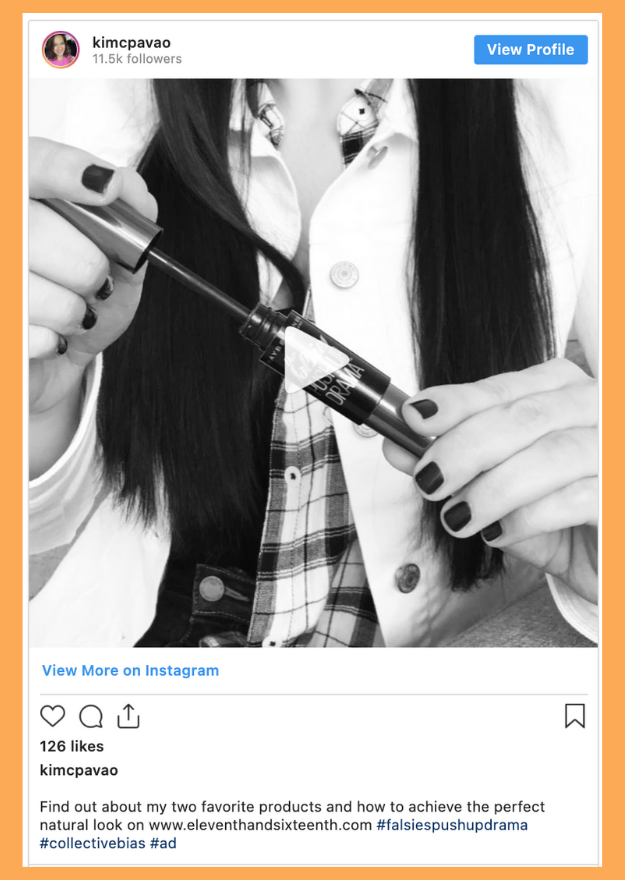
You can see just from this small sample of case studies in this influencer marketing guide, just how successful influencer marketing can be for your business.
The Future of Influencer Marketing
Influencer Marketing is most successful when it’s honest and relevant to your/your influencer’s audience. In the words of Grin, “people want to listen to an authentic voice above all the noise,” and whose voice is better than an influencer’s?
The future of influencer marketing looks bright, and it’s only going to get more and more popular. Influencer marketing is on track to be worth 15 billion US dollars by 2022. But it’s not about simply jumping on a bandwagon; influencer marketing must be specific, intentional, and strategic to be successful.
To ensure future influencer success for your brand, follow the advice in this influencer marketing guide and be sure to read our blog about the mistakes to avoid in influencer marketing.
How Giraffe Social Media Can Help You
If you’ve enjoyed this influencer marketing guide and are now looking for more information on the benefits of influencer marketing, on influencers in general, or if you want to discuss and take advantage of the new and popular way to market, follow our social media tips on Instagram or get in touch with us.
Editor’s Note: This influencer marketing guide was originally published in 2019, and has been updated in March 2021 for accuracy and relevance.



